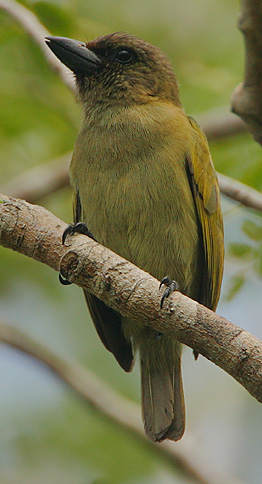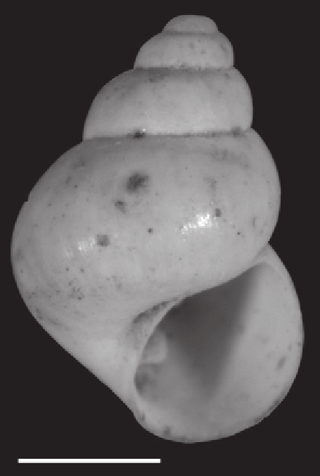
The scarlet tanager is a medium-sized American songbird. Until recently, it was placed in the tanager family (Thraupidae), but it and other members of its genus are now classified as belonging to the cardinal family (Cardinalidae). The species' plumage and vocalizations are similar to other members of the cardinal family, although the Piranga species lacks the thick conical bill that many cardinals possess. The species resides in thick deciduous woodlands and suburbs.

Mountain coatis are two species of procyonid mammals from the genus Nasuella. Unlike the larger coatis from the genus Nasua, mountain coatis only weigh 1.0–1.5 kilograms (2.2–3.3 lb) and are endemic to the north Andean highlands in South America.

The western mountain coati or western dwarf coati is a small procyonid, found in cloud forest and páramo at altitudes of 1,300–4,250 metres (4,270–13,940 ft) in the Andes of Colombia and Ecuador. A population discovered in the Apurímac–Cuzco region of southern Peru has tentatively been identified as the western mountain coati, but may represent an undescribed taxon.

Dasia olivacea, the olive dasia or olive tree skink, is a semi-arboreal species of skink lizard native to Southeast Asia.

Gastrophryne olivacea, the Great Plains narrow-mouthed toad or western narrow-mouthed toad, is a species of microhylid frog found throughout much of the south-central United States from Nebraska south through Texas, and into northern Mexico. Though not a true toad, evidenced by the smooth, moist skin, its common name obtains due to its terrestrial habit.

The olive whistler or olivaceous whistler, is a species of bird in the family Pachycephalidae, the whistlers, that is native to southeastern Australia.

The plain bush-hen is a species of bird in the family Rallidae. It is endemic to the Philippines.

The olive sunbird is a species of sunbird found in a large part of Africa south of the Sahel. It prefers forested regions, and is absent from drier, more open regions such as the Horn of Africa and most of south-central and south-western Africa. It is sometimes placed in the genus Nectarinia.

The green barbet is a species of bird in the Lybiidae family. It is found in Kenya, Tanzania, Malawi, Mozambique and South Africa. It occurs in forests from sea level to 1,800 metres (5,900 ft). Its isolated populations are vulnerable to forest clearing.

The brown-tailed mongoose, brown-tailed vontsira, Malagasy brown-tailed mongoose, or salano is a species of mammal in the family Eupleridae. It is endemic to Madagascar. Its natural habitat is moist lowland tropical forest. It is threatened by habitat loss.
Cincinnatia is a genus of very small freshwater snails that have an operculum, aquatic gastropod molluscs in the family Hydrobiidae, the mud snails.
Marstonia agarhecta, common name Ocmulgee marstonia, is a species of freshwater snail with a gill and an operculum, aquatic gastropod mollusk in the family Hydrobiidae.

Pyrgulopsis is a genus of freshwater snails with a gill and an operculum, aquatic gastropod mollusks in the family Hydrobiidae.
Marstonia castor, common name the beaver pond marstonia, is a species of very small freshwater snail with a gill and an operculum, an aquatic operculate gastropod mollusc in the family Hydrobiidae. This species was endemic to a very limited area of the US state of Georgia, mostly to streams and creeks around Lake Blackshear.
Marstonia ogmorhaphe, common names the royal marstonia or royal springsnail, is a minute species of freshwater snail, an aquatic gastropod mollusk or micromollusk in the family Hydrobiidae, the mud snails. This species is endemic to Tennessee in the United States, where it occurs in two streams in Marion County. It is a federally listed endangered species of the United States.
Marstonia ozarkensis, common name the Ozark pyrg, is a species of very small or minute freshwater snails with an operculum, aquatic gastropod molluscs in the family Hydrobiidae. This species was endemic to Missouri and Arkansas in the United States and was presumed extinct by the U.S. Fish and Wildlife Service as of December 2018.
The armored marstonia, scientific name Marstonia pachyta, also known as Pyrgulopsis pachyta, is a species of freshwater snail, an aquatic gastropod mollusc in the family Hydrobiidae.
The angular pebblesnail, scientific name Somatogyrus biangulatus, is a species of very small freshwater snail with an operculum, an aquatic operculate gastropod mollusc in the Lithoglyphidae family. This species is endemic to Alabama in the United States. Its natural habitat is Muscle Shoals region of the Tennessee River. Although the IUCN officially categorises the species as Data Deficient, it also considers it as Possibly extinct, as it has not been recorded since the river was impounded. This latter classification is also supported by The Nature Conservancy.

Marstonia is a genus of freshwater snails with a gill and an operculum, aquatic gastropod molluscs in the family Hydrobiidae.











